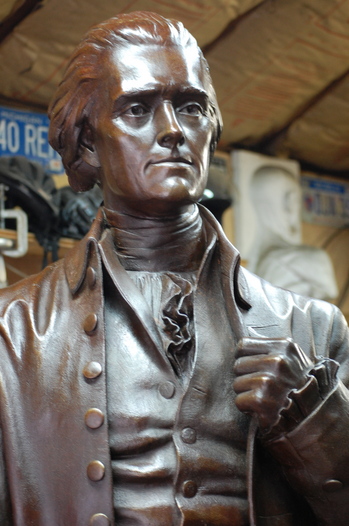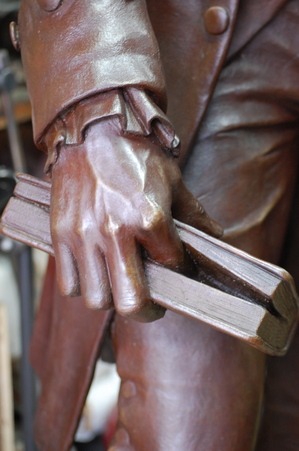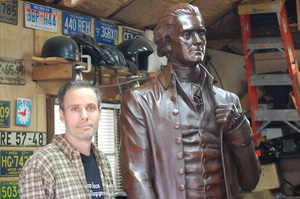
Thomas Jefferson, sculpted by Anthony Frudakis and cast in bronze by Tad McKillop.
Janet Miller | Ann Arbor.com
Frudakis and his partner in the 18-month project, foundryman and fellow sculptor Tad McKillop, said goodbye to the larger-than-life statue of the nation’s third president last week as it made its way to its new home: Thomas Jefferson High School in Council Bluffs, Iowa.
McKillop spent the summer casting Jefferson using what’s called the lost-wax process. Together, the two artists put between 800 and 1,000 hours of work into the monument. The cost of the project is estimated to be somewhere between $90,000 and $125,000.
“It was a long road,” Frudakis said.

Janet Miller | AnnArbor.com
“Tony’s a highly skilled sculptor with great attention to detail. It’s a very crafted piece,” McKillop said. “Everyone who comes into the studio knows it’s Thomas Jefferson. That’s a good sign.”
With each step - sculpting small models out of clay, creating a 2-foot clay scale model, turning that into a 7-foot urethane foam model, and making two sets of molds for the bronze - the project had to be sand blasted, refined and cleaned to maintain the original details, from the soft creases in Jefferson’s waistcoat to the surface veins in his right hand.
The lost wax process requires precision, Frudakis said. “There’s a lot of room for error. Mistakes can happen.” But the monument emerged exactly as Frudakis had envisioned, he said. “He made it look like the original, which is exactly the goal.”
McKillop made rubber and then ceramic molds for each of the six sections of the monument. Then 800 pounds of orange-hot bronze was poured into the molds. The heat is so intense, McKillop said he’s been known to scorch his own eyebrows and eyelashes. “People are always surprised by how hot it is. But that’s how bronze happens,” he said.

Tad McKillop with the finished statue.
Janet Miller | AnnArbor.com
While McKillop is a sculptor first (his art appears around Ann Arbor and beyond, including the Sauk Theater Muse in Jonesville), he is easing into casting other artists’ work. The Jefferson monument is one of his biggest projects so far.
With his own foundry nine miles north of Ann Arbor, McKillop casts all of his own work. Most sculptors don’t have the equipment and detailed knowledge to cast their own pieces, McKillop said. There aren’t many artist foundries close by, and most sculptors go to the Detroit area or beyond for casting, McKillop said.
While sculpting is creative, casting is more technical, McKillop said. “It has its rewards. I can be quite Zen-like, especially the grinding and metal work. But it’s physically hard work.”